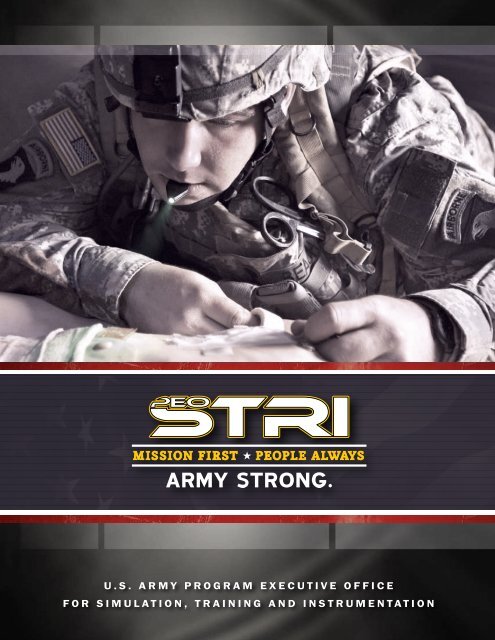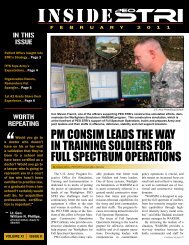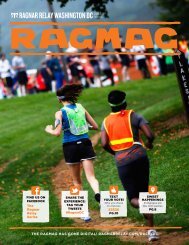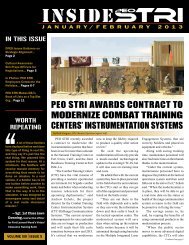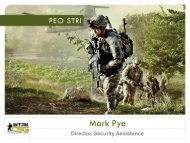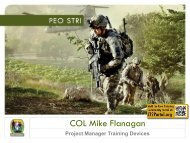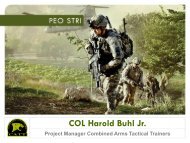Inside STRI Special Edition January - February 2009 (PDF)
Inside STRI Special Edition January - February 2009 (PDF)
Inside STRI Special Edition January - February 2009 (PDF)
You also want an ePaper? Increase the reach of your titles
YUMPU automatically turns print PDFs into web optimized ePapers that Google loves.
U.s. army Program Executive Office<br />
for Simulation, Training and Instrumentation
Contacts<br />
Program Executive Officer<br />
Dr. James Blake<br />
407-384-3502<br />
Deputy Program Executive Officer<br />
Col. Ken Wheeler<br />
407-384-3524<br />
Business Operations Executive<br />
Mr. Rob Reyenga<br />
407-384-3505<br />
Customer Support Executive<br />
Mr. Pete Marion<br />
407-384-3799<br />
Project Support Executive<br />
Ms. Traci Jones<br />
407-384-3770<br />
Project Manager Combined Arms<br />
Tactical Trainers (PM CATT)<br />
Col. Francisco Espaillat<br />
407-384-3600<br />
Project Manager Constructive<br />
Simulation (PM ConSim)<br />
Col. Karen Saunders<br />
407-384-3651<br />
Program Manager Field Operations<br />
(PM Field OPS)<br />
Mr. Russ McBride<br />
407-384-3690<br />
Project Manager Future Force<br />
(Simulation) (PM FF(S))<br />
Jeff Simons<br />
407-243-3448<br />
Project Manager Instrumentation,<br />
Targets and Threat Simulators<br />
(PM ITTS)<br />
Col. David Lockhart<br />
407-384-5250<br />
Project Manager Training Devices<br />
(PM TRADE)<br />
Col. Fred Mullins<br />
407-384-5200<br />
Principal Assistant Responsible for<br />
Contracting (PARC)<br />
Ken Tedeschi<br />
407-384-5113<br />
Who We Are<br />
What We Do<br />
How We Do It<br />
Mission<br />
Critical Tasks<br />
PEO <strong>STRI</strong> At a Glance<br />
Military, government civilians and contractor teams working together.<br />
Member of Team Orlando: Central Florida military, industry and academic institutions.<br />
Acquisition agency executing a $3.5 billion budget in support of the Army.<br />
Develop, acquire, field and sustain cutting-edge training and testing devices.<br />
Support multi-domain training in the live, virtual, constructive and gaming areas.<br />
Charter emphasizes a joint perspective to support U.S. defense initiatives.<br />
Training aids, devices and simulations supporting U.S. and coalition service members.<br />
An Army Acquisition Center of Excellence with Head of Contracting Activity authority.<br />
To provide responsive interoperable simulation, training, and testing solutions and<br />
acquisition services for the Warfighters and the nation.<br />
Provide simulation, training and testing products and services.<br />
Expand beyond the traditional products and services.<br />
Provide an integrated and interoperable infrastructure.<br />
Shape a world-class workforce with acquisition, functional and leadership skills.<br />
Provide a full range of contracting and acquisition services for effective, efficient and<br />
responsive life-cycle management.<br />
Implement U.S. Army policy for acquisition of system training devices.<br />
Public Affairs Office<br />
407-384-5224<br />
Industry Customer Contact<br />
407-384-3773<br />
www.peostri.army.mil<br />
General Information<br />
407-384-3500
James T. Blake, Ph.D.<br />
Program Executive Officer<br />
U.S. Army Program Executive Office for<br />
Simulation, Training and Instrumentation<br />
Dr. James T. Blake serves as the<br />
program executive officer for the U.S.<br />
Army PEO <strong>STRI</strong> and head of contracting<br />
activity for Army simulation, training<br />
and instrumentation. He is responsible<br />
for providing materiel solutions and<br />
services in modeling, simulation, training<br />
and test-instrumentation to support the<br />
Warfighter.<br />
Blake retired as an Army colonel after<br />
a distinguished military career. In his last<br />
assignment, Blake was the Army’s senior<br />
uniformed scientist. He is a graduate of<br />
the U.S. Army Command and General<br />
Staff College, the Defense Systems<br />
Management College, and the U.S. Army<br />
War College. He has a Ph.D. in computer<br />
science from Duke University.<br />
Following his military career,<br />
Blake held several technical and<br />
executive positions in industry before<br />
joining academia where he served as<br />
a senior research scientist at Texas<br />
A&M University. While at Texas A&M,<br />
Blake joined the Simulation, Training<br />
and Instrumentation Command as the<br />
program manager for the Institute for<br />
Creative Technologies.<br />
In March 2003, he became a member<br />
of the Senior Executive Service. From<br />
March 2003 until June 2005, Blake served<br />
as the deputy program executive officer<br />
for PEO <strong>STRI</strong>.<br />
A Message from the PEO<br />
We are in an era of persistent conflict, so therefore it is clear that our Army and its<br />
capability will be in high demand for many years to come.<br />
At PEO <strong>STRI</strong>, we are truly cognizant of this state of affairs, and as such, we are preparing<br />
the Soldier of today, and the Soldier of tomorrow, with the best available training enablers.<br />
Whether our force is engaged in peace keeping missions, counterinsurgency, or major<br />
combat operations, we pledge to provide timely, realistic, readily-available, cost efficient<br />
and safe training to America’s greatest asset, its Warfighters.<br />
When we learned of the critical need for operator training for Mine Resistant Ambush<br />
Protected vehicles, PEO <strong>STRI</strong> quickly responded by getting MRAP driver and egress trainers<br />
into the hands of our Warfighters.<br />
Similarly, we have become strikingly aware of the benefits that gaming technology<br />
provides our younger Soldiers in honing their decision-making, communication and team<br />
building skills. In response, PEO <strong>STRI</strong> replaced the original game we were fielding with<br />
one that is more attuned to the situations our Soldiers face on today’s battlefield.<br />
In order to get these training enablers to our Warfighters in an accelerated manner,<br />
we are committed to an efficient approach to Army acquisition. Our recent award of the<br />
second <strong>STRI</strong> Omnibus Contract, or STOC II, is a clear example of our commitment.<br />
PEO <strong>STRI</strong> is one element of the Army’s acquisition team in which we work closely<br />
with our combat developers to find solutions to procurement challenges. Without a doubt,<br />
we could not accomplish this large task without a highly professional and well-educated<br />
workforce. In order to keep our team at an optimal level, we have created an Acquisition<br />
Academy to introduce new employees to the federal workforce through an 11-week<br />
Army internship program.<br />
In the next few pages, you will find many examples of what derives from a strong<br />
workforce coupled with an unwavering dedication to the Warfighter. Mission first, people<br />
always. Army Strong!
New MRAP Vehicles<br />
Call for New Training<br />
As the Mine Resistant Ambush Protected<br />
(MRAP) family of fighting vehicles became<br />
the highest-sought mode of transportation<br />
in the combat zone, PEO <strong>STRI</strong> responded<br />
with a driver and egress trainer to prepare<br />
Soldiers for the new vehicle they would be<br />
operating.<br />
Specifically, Soldiers at Camp Shelby,<br />
Miss., were the first to receive the driver<br />
trainer Jan. 27, <strong>2009</strong>, and Warfighters in Iraq<br />
will be the first to get the egress trainer the<br />
end of <strong>February</strong> <strong>2009</strong>. In total, 20 driver<br />
trainers are expected to be delivered over<br />
the next year, and nearly 30 egress trainers<br />
are scheduled to be fielded in the coming<br />
months.<br />
The driver trainer, called the Common<br />
Driver Trainer MRAP variant, “trains critical<br />
driver tasks in a virtual simulator that are<br />
too dangerous or infrequently trained in<br />
the live training environment,” said Lt. Col.<br />
Charlie Stein, product manager for ground<br />
combat tactical trainers.<br />
Some of the dangerous situations<br />
that Soldiers are currently encountering<br />
in theater that this trainer takes into<br />
consideration are bad driving conditions<br />
like dilapidated roads and weak bridges,<br />
combat conditions like roadside bombs or<br />
ambushes, and mere driver error.<br />
While the training mission is relatively<br />
the same for all the Soldiers using the<br />
simulation, the type of vehicle they will<br />
be operating in the war zone could very<br />
well vary as there are a handful of different<br />
MRAP vehicles in Iraq and Afghanistan.<br />
As a result, PEO <strong>STRI</strong> will field five types<br />
of MRAP vehicles: a mine-resistant light<br />
armored vehicle (RG-33L), a multipurpose<br />
mine-protected vehicle (RG-31), an<br />
armored fighting vehicle (MaxxPro), an<br />
armored vehicle with a V-hull design based<br />
on the Family of Medium Tactical Vehicles<br />
(Caiman), and the Marines’ armored<br />
fighting vehicle (Cougar).<br />
“With the driver trainer, we are<br />
U.S. Army Photo/Norbert Granchi<br />
The Mine Resistant Ambush Protected (MRAP) vehicles are a family of armored fighting vehicles designed to increase<br />
survivability of improvised explosive device attacks and ambushes. This is a photo of an MRAP vehicle located at<br />
Firebase Ripley in the southern region of Afghanistan.<br />
focusing on the fidelity of the vehicle<br />
and its dynamics—the point at which the<br />
vehicle will rollover,” Stein explained. “To<br />
accurately do this, we’ve worked with<br />
the subject matter experts in this field:<br />
equipment manufacturers and Soldiers<br />
who’ve operated an MRAP in theater.”<br />
The CDT-MRAP variant is based on PEO<br />
<strong>STRI</strong>’s original driver trainer for the Stryker<br />
vehicle and the follow-on improvements<br />
made with the tank variant.<br />
“It was beneficial to model the new<br />
MRAP driver trainers on previous driver<br />
trainers because we were able leverage<br />
the same motion base and instructor<br />
stations on the Stryker and tank variants,”<br />
Stein said.<br />
“This gives units the flexibility to change<br />
cabs and train on the MRAP, Stryker, tank,<br />
and some day in the near future, a tactical<br />
wheeled vehicle,” he noted.<br />
Much like the Stryker and tank driver<br />
trainers, the MRAP trainer also includes<br />
a motion platform, image generators, an<br />
instructor/operator station and an after<br />
action review station. Most importantly, the<br />
Common Driver Trainer family of driving<br />
simulations is modular, interchangeable and<br />
allows multiple variants to be compatible<br />
with the common training platform.<br />
“All these qualities are important<br />
because they contribute to maintainability,<br />
sustainability and a cost-avoidance to the<br />
Army,” Stein said.<br />
As with the driver trainer, the egress<br />
trainer enables the Soldier to become<br />
proficient in tasks which cannot be taught<br />
in a live environment.<br />
The MRAP egress trainer is modeled on<br />
PEO <strong>STRI</strong>’s High Mobility Multipurpose<br />
Wheeled Vehicle Egress Assistance Trainer,<br />
and much like its predecessor, the “MRAP<br />
trainer proves to be an Army solution to<br />
an Army problem,” noted Dr. James Blake,<br />
program executive officer for PEO <strong>STRI</strong>.<br />
Many organizations within the Army<br />
came together to make both egress<br />
trainers a reality. The Tank-Automotive<br />
Research, Development and Engineering<br />
Center designed and built the prototype.<br />
The effort was funded by the Army and<br />
the Marines’ joint office, Program Manager<br />
MRAP.<br />
Once the prototype was certified for<br />
safety, the Red River Army Depot began<br />
production of the trainers based on the<br />
prototype.<br />
Continued on next page
Contracting Vehicle Positions PEO <strong>STRI</strong><br />
to Better Support U.S. and Coalition Troops<br />
PEO <strong>STRI</strong> granted 142 awards to more<br />
than 120 companies for the second <strong>STRI</strong><br />
Omnibus Contract, known as STOC II,<br />
Jan. 27, <strong>2009</strong>. STOC II, valued at $17.5<br />
billion over the next 10 years, serves as<br />
an efficient contracting vehicle in order to<br />
quickly get simulation and training products<br />
and services into the hands of U.S. and<br />
coalition service members.<br />
“STOC II is PEO <strong>STRI</strong>’s newest contract<br />
vehicle providing continued responsiveness<br />
to the Warfighter,” noted John Daniele,<br />
deputy customer support executive for<br />
PEO <strong>STRI</strong>. “It is positioned and structured<br />
to meet the demands of the current and<br />
future operating environments with<br />
relevant and responsive solutions for the<br />
nation.”<br />
Companies competing in STOC II were<br />
evaluated in two categories: the Full and<br />
Open Lot and the Partial Small Business<br />
Set Aside Lot. Small companies competing<br />
in the Full and Open Lot also had the<br />
opportunity to compete in the Partial Small<br />
Business Set-Aside Lot, and vice-versa.<br />
Two lots were established in order to<br />
enhance PEO <strong>STRI</strong>’s ability to achieve its<br />
small business goals.<br />
In response to the STOC II Request for<br />
Proposal, PEO <strong>STRI</strong> evaluated 158 compliant<br />
proposals in which 127 proposals (60 large<br />
companies and 67 small companies) were<br />
entertained in the Full and Open Lot, and<br />
98 proposals were assessed in the Partial<br />
Small Business Set-Aside Lot.<br />
The proposals were evaluated based on<br />
four core factors detailed in the Request for<br />
Proposal: past performance, management,<br />
small business participation plan (applicable<br />
only to the large companies in the Full and<br />
Open Lot) and cost/price.<br />
“The overall purpose of STOC II is to<br />
have highly-qualified contractors on-hand<br />
to rapidly satisfy the needs of our nation’s<br />
Warfighters,” explained Brian Murphy, the<br />
PEO <strong>STRI</strong> contracting officer responsible<br />
for STOC II.<br />
Existing STOC I contracts—which<br />
were awarded in four different categories:<br />
Live, Virtual, Constructive and Test-<br />
Instrumentation—remain a viable solution<br />
during the transition period until each<br />
respective domain expires. The first<br />
domain, Test-Instrumentation, expires late<br />
<strong>February</strong>, <strong>2009</strong>. The remaining domains<br />
expire March <strong>2009</strong>.<br />
“Leveraging experience with the<br />
STOC I contract, STOC II accommodates<br />
emerging requirements, technologies and<br />
innovation via access to an extensive array<br />
of industry and academia capabilities,”<br />
Daniele advised.<br />
Companies outside of STOC II will still<br />
be able to do business with PEO <strong>STRI</strong>.<br />
Murphy advises, “STOC II is just one tool<br />
in a contracting officer’s toolkit.” <br />
Mine Resistant Ambush Protected<br />
(MRAP) Vehicles Continued. . .<br />
Finally, PEO <strong>STRI</strong> is responsible for<br />
getting the device into the hands of the<br />
Warfighters in which the initial fielding<br />
schedule calls for 25 egress trainers to<br />
go to the Army in the theater of combat<br />
operations. Additionally, three devices will<br />
go to the Marines.<br />
“Without a doubt, MRAP driver and<br />
egress trainers are important because<br />
many of the Soldiers and Marines driving<br />
MRAP vehicles down range won’t get<br />
the opportunity to operate these vehicle<br />
until they’re in the theater of combat<br />
operations. We are giving our Warfighters<br />
the opportunity to train prior to getting in<br />
the seat,” Stein said. <br />
U.S. Army Photo/Red River Army Depot<br />
PEO <strong>STRI</strong>’s Common Driver Trainer MRAP variant provides Soldiers the opportunity to train on a simulated vehicle<br />
before operating the actual MRAP in Iraq or Afghanistan. The first MRAP driver trainer, pictured above, was<br />
delivered to Camp Shelby, Miss., <strong>January</strong> 2008. A total of 20 trainers are expected to be fielded in <strong>2009</strong>.
Army Takes Gaming to the Next Level<br />
Soldiers all over the United States, and<br />
even in three locations abroad, will soon<br />
be training on the Army’s newest game,<br />
Virtual Battlespace 2, or VBS-2 for short. In<br />
fact, Soldiers at Fort Hood, Texas, were the<br />
first to receive the Army’s official game for<br />
training in early <strong>February</strong> <strong>2009</strong>.<br />
PEO <strong>STRI</strong>, will continue the fielding of<br />
VBS-2 to Forts Bragg, N.C., Carson, Colo.,<br />
and Lewis, Wash.., through March <strong>2009</strong>.<br />
“The Army takes gaming technology<br />
seriously because small unit leaders are<br />
highly receptive to using a technology<br />
they have grown up with. Small units use<br />
games for training to refine decision-making<br />
skills associated with shoot, move and<br />
communicate collective tasks in a mounted<br />
or dismounted environment,” explained Lt.<br />
Col. Gary Stephens, product manager for<br />
air and command tactical trainers.<br />
VBS-2, the Army’s next generation of<br />
games for training, was procured by PEO<br />
<strong>STRI</strong> in response to an operational needs<br />
statement from the U.S. Army Forces<br />
Command. The contract was awarded<br />
Dec. 19, 2008 to Laser Shot, Inc., for $17.7<br />
million over the next five years. In addition<br />
to the contract award for software, PEO<br />
<strong>STRI</strong> awarded a $6 million contract to<br />
CDW-G for the actual computers.<br />
From <strong>February</strong> to September <strong>2009</strong>,<br />
PEO <strong>STRI</strong> will field 70 training systems<br />
to 53 locations across the continental<br />
United States, Germany, Italy and South<br />
Korea. Each system consists of 52 laptop<br />
computers and the associated peripheral<br />
gaming equipment.<br />
Previous to VBS-2, PEO <strong>STRI</strong> fielded<br />
the original game for training Soldiers,<br />
DARWARS Ambush!. The effort fielded<br />
3,000 copies of the game to the Army,<br />
Navy, Air Force, Marines, Coast Guard and<br />
Department of Homeland Defense since<br />
2006.<br />
Much like DARWARS Ambush!, VBS-2 is<br />
a first-person shooter game that portrays<br />
a realistic operational environment. In<br />
addition, both games offer an after action<br />
review capability.<br />
The new game, however, has significant<br />
improvements over its predecessor.<br />
First, the geographical terrain database<br />
has increased from 13 kilometers by 13<br />
kilometers to 100 kilometers by 100<br />
kilometers. “The larger geographical space<br />
better represents the current operational<br />
environment,” Stephens said.<br />
Secondly, VBS-2 offers a threedimensional<br />
mission editor that allows users<br />
to make changes to the training scenario in<br />
real time. Additionally, a more user-friendly<br />
mission editor permits users to easily create<br />
training scenarios that are designated to<br />
meet training objectives.<br />
Furthermore, the new game includes<br />
a Distributed Interactive Simulation-High<br />
Level Architecture interface that allows the<br />
system to interoperate with other virtual,<br />
constructive and battle command systems.<br />
While PEO <strong>STRI</strong> is responsible for<br />
acquiring and fielding the game, the Training<br />
and Doctrine Command Training Capabilities<br />
Manager for Gaming is responsible for<br />
determining requirements and what skills<br />
Soldiers should learn from the game.<br />
The game replicates what Soldiers<br />
encounter on today’s battlefield so that<br />
users can practice a multitude of kinetic<br />
and non-kinetic skills—everything from<br />
operating in an urban terrain and reacting to<br />
ambush operations to cultural and language<br />
awareness, explained Col. Mark McManigal,<br />
the TRADOC capabilities manager for<br />
gaming. <br />
Did You know?<br />
One of the Army’s new field<br />
manuals, Training for Full<br />
Spectrum Operations, states that<br />
gaming is the use of technology<br />
employing commercial or<br />
government off-the-shelf, multigenre<br />
games in a realistic,<br />
semi-immersive environment to<br />
support education and training.<br />
Although the Army has used<br />
games informally for many<br />
years, it had never established<br />
a formal sustainable program<br />
for the acquisition and use of<br />
games until April 2008. VBS-<br />
2 was developed as the first<br />
official Army game to train and<br />
educate Soldiers, leaders and<br />
organizations.<br />
U.S. Army Photo/Training and Doctrine Command Capabilities Manager for Gaming Photo<br />
PEO <strong>STRI</strong> began fielding Virtual Battlespace 2, the Army’s newest computer game for training, <strong>February</strong> 2008. The<br />
game replicates the environment and situations that Soldiers are facing in the current theater of combat operations.
Acquisition Academy: Helping to Improve<br />
the Way New Employees are Introduced<br />
to the Federal Government Workforce<br />
Don’t Miss PEO <strong>STRI</strong> at<br />
the Following Events<br />
In October 2008, PEO <strong>STRI</strong> graduated<br />
its first Acquisition Academy class of 21<br />
contract specialist interns in which all of<br />
the students successfully completed the<br />
coursework and earned themselves a<br />
position in the organization’s Acquisition<br />
Center. Due to the success of the inaugural<br />
class, PEO <strong>STRI</strong> will kick-off the second<br />
Acquisition Academy class March 2008.<br />
While the first class focused primarily<br />
on Army contracting, the subsequent<br />
course covers an array of acquisitionrelated<br />
career fields: engineering, budget<br />
and program analysis, acquisition logistics,<br />
program management and contracting. As<br />
such, nearly 20 Acquisition Academy interns<br />
were hired into a specific career path.<br />
“For the second class, we wanted<br />
to create an integrated product team<br />
environment,” said Jean Burmester, dean of<br />
the Acquisition Academy. “With the multiple<br />
career programs integrated into one class,<br />
the interns will experience a typical work<br />
environment where many different people<br />
representing various functional areas work<br />
together on a program.”<br />
The class—comprised of two project<br />
directors, three program analysts, a<br />
logistics management specialist, two<br />
budget analysts, six contract specialists<br />
and four engineers—will learn about their<br />
functional areas by studying an actual PEO<br />
<strong>STRI</strong> program: the Multiple Integrated<br />
Laser Engagement System.<br />
In addition to the career-specific work,<br />
the interns will accomplish a multitude of<br />
administrative tasks during the 11-week<br />
multidisciplinary program. They will apply<br />
for and receive security clearances, e-mail<br />
accounts and identification badges and<br />
cards.<br />
Interns will also learn important<br />
information about federal employment,<br />
like government benefits, how to correctly<br />
report time and attendance, and how<br />
to use the Defense Travel System. They<br />
will receive ethics training, an orientation<br />
from their functional career representative<br />
and information on the National Security<br />
Personnel System.<br />
The interns will also learn about the PEO<br />
<strong>STRI</strong> mission, its strategic plan and the role<br />
of each of the project managers. They<br />
will be taught about Army organizations,<br />
installations, ranks and how the Army is<br />
structured.<br />
“During the course, the class will travel<br />
to a nearby Army installation to see how<br />
Soldiers live and train,” Burmester noted.<br />
“The interns will even see many of the<br />
training products and services they will be<br />
supporting at PEO <strong>STRI</strong>.”<br />
Upon the completion of the course,<br />
Burmester said success will be defined not<br />
only by attracting, but more importantly,<br />
retaining the new federal employees<br />
that, through the Academy, will have the<br />
essential knowledge and skills necessary<br />
for successful acquisition management at<br />
PEO <strong>STRI</strong>.<br />
“Ensuring interns are provided the<br />
appropriate acquisition and functional<br />
requirements will go a long way in enabling<br />
PEO <strong>STRI</strong> to meet the Warfighters’ vital<br />
mission requirements,” Burmester noted.
12350 Research parkway<br />
orlando, fl 32826-3276<br />
http://www.peostri.army.mil


